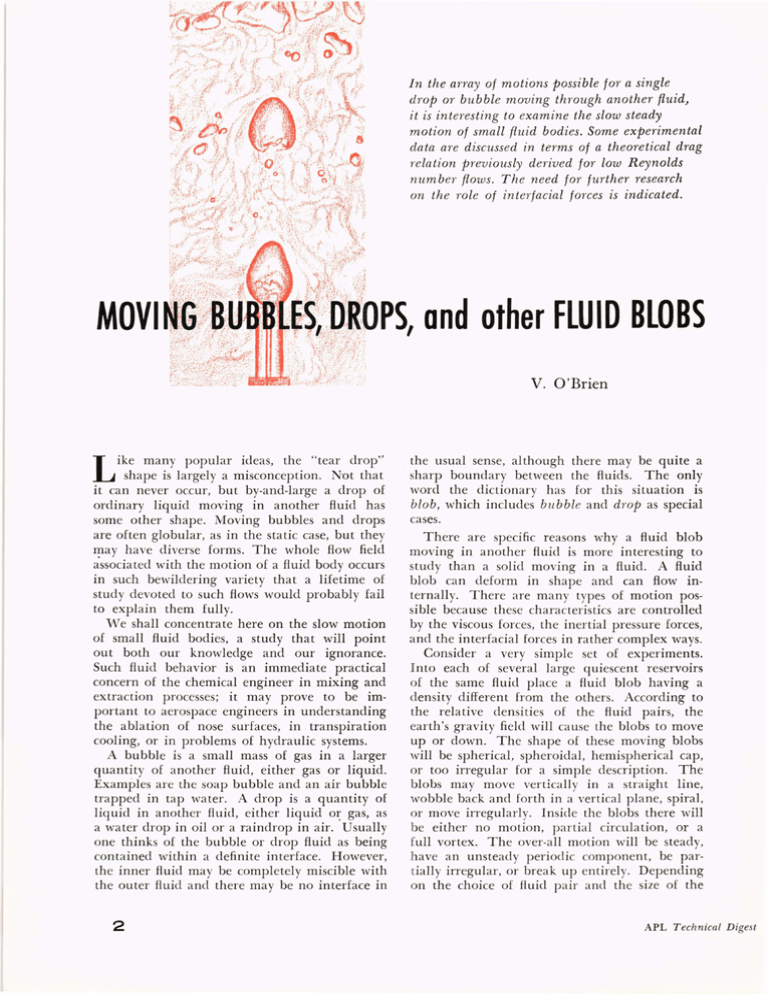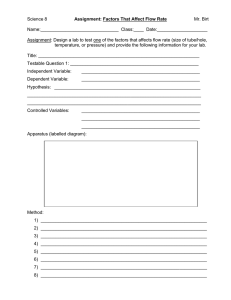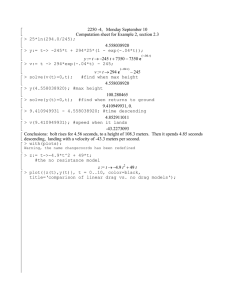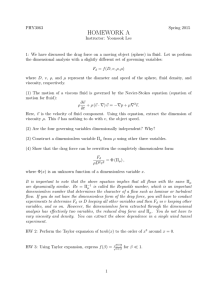L
advertisement

In the array of motions possible for a single drop or bubble moving through another fluid~ it is interesting to examine the slow steady motion of small fluid bodies. Some experimental data are discussed in terms of a theoretical drag relation previously derived for low Reynolds number flows. The need for further research on the Tole of interfacial forces is indicated. V. O'Brien ike many popular ideas, the "tear drop" shape is largely a misconception. Not that it can never occur, but by-and-Iarge a drop of ordinary liquid moving in another fluid has some other shape. Moving bubbles and drops are often globular, as in the static case, but they may have diverse forms. The whole flow field associated with the motion of a fluid body occurs in such bewildering variety that a lifetime of study devoted to such flows would probably fail to explain them fully. We shall concentrate here on the slow motion of small fluid bodies, a study that will point out both our knowledge and our ignorance. Such fluid behavior is an immediate practical concern of the chemical engineer in mixing and extraction processes; it may prove to be important to aerospace engineers in understanding the ablation of nose surfaces, in transpiration cooling, or in problems of hydraulic systems. A bubble is a small mass of gas in a larger qu.antity of another fluid, either gas or liquid. Examples are the soap bubble and an air bubble trapped in tap water. A drop is a quantity of liquid in another fluid, either liquid o~ gas, as a water drop in oil or a raindrop in air. Usually one thinks of the bubble or drop fluid as being contained within a definite interface. However, the inner fluid may be completely miscible with the outer fluid and there may be no interface in L 2 the usual sense, although there may be quite a. sharp boundary between the fluids. The only word the dictionary has for this situation is blob, which includes bubble and dTop as special cases. There are specific reasons why a fluid blob moving in another fluid is more interesting to tudy than a solid moving in a fluid. A fluid blob can deform in shape and can flow internally. There are many types of motion posible because these characteristics are controlled by the viscous forces, the inertial pressure forces, and the interfacial forces in rather complex ways. Consider a very simple set of experiments. I nto each of several large quiescent reservoirs of the same fluid place a fluid blob having a density different from the others. According to the relative densities of the fluid pairs, the earth's gravity field will cause the blobs to move up or down. The shape of these moving blobs will be spherical, spheroidal, hemispherical cap, or too irregular for a simple description. The blobs may move vertically in a straight line, wobble back and forth in a vertical plane, spiral, or move irregularl y. Inside the blobs there will be either no motion, partial circulation, or a full vortex. The over-all motion will be steady, have an unsteady periodic component, be partially irregular, or break up entirely. Depending on the choice of fluid pair and the size of the APL Technical Digest A-SPHERICAL BUBBLE. STEADY STRAIGHT-LINE MOTION. FULL VORTEX . B-SPHEROIDAL FLAT-NOSED DROP, STEADY STRAIGHT-LINE MOTION, FULL VORTEX. C-SPHEROIDAL FLAT-REAR DROP . STEADY STRAIGHT-LINE MOTION, • PARTIAL CIRCULATION. D-SPHEROIDAL BUBBLE . PERIODIC WOBBLE MOTION. E-HEMISPHERICAL CAP BUBBLE, STEADY MOTION WITH TURBULENT WAKE. F - DROP WITH INDENTED REAR, STEADY STRAIGHT-LINE MOTION, FULL CIRCULATION. EARLY LATER STILL LATER G-MISCIBLE DROP, UNSTEADY MOTION CALLED "VORTEX BREAK-UP," EARLY LATER STILL LATER H-IMMISCIBLE DROP, UNSTEADY MOTION TO BREAK-UP, Fig. I-A r e presentative sele ction of qua lita tive flo w p a tte rns s howing shapes and velocities of blobs, and vortex motion. May ·June 1962 3 blob, there can be various combinations of the characteristics above. There can be one type of motion at one time and another later. Figure I illustrates qualitatively some of these cases, with arrows showing direction of blob motion. In general, the greater ~istortions in shape and unsteady motion are found for the larger blob volumes, except for the miscible cases that are unsteady for all volumes. The initial conditions of the experiment consist of only two fluids and a blob volume. We might expect that such fluid fields could be explained quantitatively with a very few characteristic non-dimensional numbers; attempts to do this, however, have only provided qualitative information. It appears that not only the usual bulk fluid properties of viscosity and density, but the detailed conditions at the boundary between the fluids as well, are necessary. Bubbles A comprehensive survey of single air-bubble motion in various fluids was published several years ago. 1 An attempt was made to relate the bubble drag coefficient-an easily-obtained net measure of the viscous retarding force-to the three non-dimensional parameters Re, We, and .M. Reynolds number, Re == VIp / fL' is the ratio of inertial and viscous forces; \tVeber's number, We == V2lp / 0-, is the ratio of inertial and surface tension forces; Rosenberg's system parameter, M == PfL4 / g0-3, is independent of bubble size and speed. In these rela tions, V is a characteristic velocity, I is a characteristic length, g is the gravitational acceleration constant, 0- is the static surface tension, and p and fL are the density and viscosity of the liquid, respectively. Universal curves in terms of these three parameters could not be drawn from the data since a complete description of the various flow regimes probably depends on still-unknown interfacial properties. It is possible, however, to relate the measured drag of the bubble quantitatively to certain features of the flow field. The three important features to be discussed are internal circulation, body shape, and Reynolds number. ·F or a spherical body and low Re, the governing Huid dynamic equation for steady motion h as been solved. Flow patterns of the velocity field and theoretical drag values that compare 1 W. L . Haberman and R. K. Morton, "An Experimental Investigation of the Drag and Shape of Air Bubbles Rising in Various Liquids ," David Taylor Model Basin Rept. 802, s.~pt. 1953. (See also, Haberman and Morton, "An Experimental Study of Bubbles Moving in Liquids," Trans. Am. Soc. Civil Engrs., 121, 1956, 227-252.) 4 with measured drag values are found by varying the boundary conditions imposed at the interface. The Stokes flow solution (Re<O.l) for a spherical drop with complete circulation has been known for half a century. Surprisingly it does not depend on the static interfacial tension value 0-. The tangential shearing stress is assumed to be continuous across the interface. The shearing motion of the outside fluid would in all likelihood cause full circulation of the viscous fluid inside. Thus, unless the interface has some resistance to the tangential shearing force, the fluid body is a spherical vortex. The Stokes drag relation is an inverse linear function of R e for either a rigid sphere or a fully-circulating fluid sphere. The latter case depends on the ratio of the viscosities of the inner and the outer fluids. Typical variation is shown in Fig. 2 where the drag coefficient CD for the fluid vortex sphere is less than for the corresponding rigid sphere. Stated another way, a circulating fluid sphere rises or falls faster than a rigid sphere of the same density moving in the same viscous liquid. 1000 -0 ~ ~IOO 1&1 U it 1&1 o o 10 C) « 0: o IO~.O~I-""""""""'O.l I 10 100 REYNOLDS NUMBER (Red) F'ig. 2-Theoretical drag for spherical bodies. It is possible for a fluid blob to retain its spherical shape beyond the low Re where the Stokes approximations are valid. Solutions correct to the first-order in R e show that the drag will be increased over the Stokes drag for both the rigid and circulating spheres (Fig. 2).2 Many blobs begin to deform to an approximate oblate spheroid even at relatively low Re (Figs. I B and C). The Stokes drag for a solid 2 V. O'Brien, "An Inves tigation of Vi scous Vortex Motion: The Vortex Ring Cascade," (Doctoral dissertation, The Johns Hopkins Univers ity, 1960). APL Technical Digest '0 ~ ~ IOO I::-----~-" LLJ U ~ u.. LLJ o(.J (!) ct a: o '0.01 0.1 I 10 100 REYNOLDS NUMBER (ReJ Fig. 3-Measured drag for air bubbles. spheroid is well known and depends on the eccentricity of the meridian section. A flow solution for a spheroidal vortex has been obtained recently.3 By matching tangential shear a~ the .interfa:e, a dra?" relation for a fullyCIrculatmg fluId spherOId can be obtained. It depends upon both the eccentricity of the crosssection and the ratio of blob viscosity to outside-liquid viscosity, IL' / IL' in 'opposing fashion. An oblate spheroid always has higher drag than a sphere of the same volume, drag increasing as the eccentricity increases. As with the fluidvortex sphere, the circulating spheroid has less drag than the rigid body. The drag depends on the viscosity ratio, being least for vanishing IL' / IL· The effect is a translation upward of the three curves in Fig. 2 for a given spheroidal body. . D~ta for air bubbles rising in four typical lIquIds (from Ref. 1) are shown in Fig. 3. Without resistive, tangential, interfacial forces acting on these bubbles, one would expect full circulation. Because of the low gas viscosity, the data should lie on the lowest curve of Fig. 2 during the period when the shape is spherical. As Re increases, the ~hape is likely to become more spheroidal, with a resultant upward shift in drag (deformation depending on the resistance to the deforming normal pressure forces). At the very lowest Re, which is the Stokes flow regime, air bubbles seem to be rigid; the drag is just Stokes drag for a rigid sphere. Although Ref. 1 did not reveal circulation patterns within the bubbles directly, other work has shown that • 3 V. O ' Brien, "Steady Spheroidal Vortices- More Exact Solur~o6~~ ~~3:f:8 .Navier-Stokes Equation," Quart . Appl. Math., 19, M ay -June 1962 they do exist, but only for the higher Re. At a certain Re, the circulation appears first at the front of the fluid parcel (Fig. 1C). As Re increases, the circulation covers a greater portion of the interior until the whole is circulating. It s:ems e~ident that the bubble in the syrup is CIrculatIng at very low Re; the bubble in oil begins to circulate later and shows deformation effects at an Re of 1.0. Circulation within the bubble in either water or the corn syrup solution is inhibited throughout this low Re range. There is no parameter yet to explain this difference in circulation. Without doubt, both circulation and deformation are intimately connected with the dynamic characteristics of the interface. Unfortunately, however, studies of these properties are spotty, and suitable data are very sparse. Drops Data similar to those for bubbles have been presented for drops moving in liquids for a number of liquid pairs. 4 ,5 Unhappily, the overall pattern of behavior seems to have more variety than the gas bubbles at the higher Reynolds numbers. The differences are probably d..ue to the range of interfacial tensions of these systems while the gas-liquid pair almost invariably has a high interfacial tension value. However, in the lower Re ranges the behavior is remarkably similar. Very tiny drops do not circulate at all, and measured drags lie on the Stokes rigidsphere line. As Re increases, circulation begins inside the drops and the drag values drop from the rigid to the fully-circulating fluid-sphere curve. If deformation takes place, the drag curves rise above the sphere values . For the fluid vortex sphere, the dip of the drag curve below the rigid-sphere curve depends on the viscosity ratio of the system. For comparison with air bubble data in Fig. 3, consider only the drop systems where the viscosity ratio IL' / IL ~ O. Figure 4 shows some data on tetrachloroethylene, bromobenzene, and ethylbromide drops through 80-100% glycerin, and tetrachloroethylene through a 68 % corn syrup solution. These drops seem to be fully circulating at small Re. The validity of the first-order approximation theory is restricted to Re L. 1, but apparently it is an overestimate for 1 < R e L. 10. Thus, the first-order drag rela4 M. Warshay et al, " Ultimate Velocity of Drops in Stationary Liquid Media," Can. J . Chem. Eng., 37, 1959, 29-36 . 5 R . Satapathy and W. Smith, "The Motion of Single lm~t~~~~ Drops Through a Liquid," J. Fluid Meeh., 10, 1961, 5 ~OO r---~~~-r'-rrrrr---~--'--r'-~~r---~--'-'-'-~~ l rr l ----,-~I--~-r~~ TETRACHLOROETHYLENE IN CORN SYRUP (Ref 4) TETRACHLOROETHYLENE IN GLYCERIN (Ref 4) TETRACHLOROETHYLENE IN GLYCERIN (Ref 5) BROMO BENZENE IN GLYCERIN (Ref 5) ETHYLBROMIDE IN GLYCERIN (Ref 5) A o CJ <> _ IOO ~--------------~~r-~--------+---------------4---------------~ o ~ t- ~ u it ~ Sl !i IO ~--------------~--------------~~~~--~~----+---------------~ .............. •...••...·RIGID SPHERE I I I " I 100 REYNOLDS NUMBER (R~) Fig. 4-Measured drag for falling spherical drops. tion and the Stokes drag relation 6 provide upper and lower bounds on the actual drag in this range. Blobs In the absence of an interface, the blob motion is always unsteady. The importance of the vortex pattern, and the change with time in appearance of a liquid blob until it ultimately breaks up (Fig. IG), have been described before. 7 By increasing the drop volume sufficiently, in the case of immiscible falling drops, a point is often reached where the drop breaks up. The deformation and breakup for: these drops are quite similar to the miscible blob behavior (see Fig. IH and Ref. 7). It is very likely that the "vortex-breakup" behavior depends on the tangential, dynamic, interfacial characteristics. 6 M. J. Hadamard, "Mouvement permanent lent d'une sphere liquide et visqueuse dans un liquid visqueux," Compt. rend., 152, 1911, 1735-1738. 7 V. O'Brien, "Why Raindrops Break Up-Vortex Instability," J. M et eorol., 18, 1961, 549-552. 6 While no attempt has been made to cover fully all the aspects of the moving blob problem, the importance of the influence of the interfacial characteristics on the qualitative regimes of blob motion has been stressed. The main points of the low Re flow about bubbles, drops, and other blobs can be summarized: 1. Viscosity and shear cause circulation. 2. Circulation causes drag decrease (velocity rise). 3. Inertial effects cause drag rise. 4. Pressure forces cause change in body shape and, thus, further drag rise. 5. Interfacial forces oppose transmission of tangential shear and, therefore, oppose circula tion. 6. Interfacial forces resist change in shape. Much more research on the role of interfacial forces must be done before a quantitative explanation of the onset of circulation and the deformation of the blob can be obtained. APL Technical Digest






